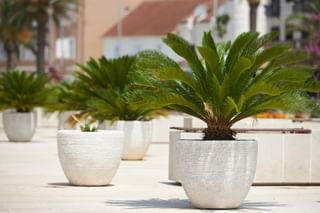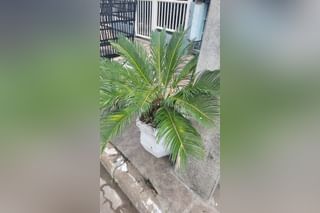How to take care of Cycas revoluta (Sago Palm)
Discover my simple and friendly guide on how to care for your Cycas revoluta, also known as the Sago Palm. I’ll walk you through easy steps to keep your plant healthy and thriving. Whether you’re a beginner or just need a little help, I'm here for you! Let's make your Sago Palm a beautiful part of your home.
Are you looking to create a beach vibe in your house or garden? You can't miss out on the Cycas revoluta, probably better known as the Sago Palm. This plant makes any space look tropical and beachy. Even if you're not looking to create a beach vibe, this plant will be a unique addition to any house or garden!
In this plant care guide, we'll look at taking care of this unique palm and what you can do to keep it healthy for many years to come! These are the topics we're going to look at:
Let's get started with the basics!
What is Cycas revoluta?
The Cycas revoluta, or Sago palm, is not actually a palm tree. It's much older than that, because it's actually a cycad. This is a type of plant that was around when the dinosaurs still walked the earth!
It's a plant, that unlike most other plants I write about, is from southern Japan. It loves subtropical climates where it's warm and humid and is very low-maintenance. It's a tough plant!
Because it's such a tough, low-maintenance plant, you probably aren't surprised to find out that this plant can live for 100 years or more. It's a very slow-growing plant that takes decades to become a mature plant. So this plant, that belongs to an ancient group of plants is perfect for you if you want to get it and forget it.
Sunlight for Cycas revoluta

The ideal sunlight exposure for Cycas revoluta is bright, indirect sunlight. In nature, this plant grows in partial sunlight conditions. If you want to grow these amazing plants indoors, it's a good idea to place them near a bright window that gives the plant bright, indirect sunlight.
This plant can tolerate lower light conditions as well, but its growth will slow down. While the Sago palm likes bright, indirect light, it's not so happy in direct sunlight. Direct sunlight tends to scorch its leaves, especially if you've got a young plant or if it's putting out new leaves.
Growing Cycas revoluta outdoors
If you've got the perfect spot for your palm outdoors, you might want to consider bringing this plant outdoors! If you live in USDA zones 9 to 11, where the temperature never really goes below freezing, you can keep this plant outdoors all year round.
If the temperature drops below freezing briefly, this is no problem either. However, if it's consistently freezing, your plant might suffer from frost damage. So if it's warm enough where you live, you should try to move this plant outdoors!
Ideal temperature
These plants prefer warm temperatures, so ideally they're growing in 18°C to 29°C (65°F to 85°F) during the day and during the night, the temperature should stay above 10°C (50°F). As I mentioned, it's fine if the temperature drops below freezing, but not for too long.
Watering your Cycas revoluta
Like many other (sub)tropical plants, this plant likes to be watered regularly. But how often? Well, it depends on 2 things: your (indoor) climate and the soil it's growing in.
On average, in the spring and summer, you should water your palm once per week. But you should always check if the top 1-2 inches of the soil is dry before you water your amazing plant. By checking if the top of the soil is dry, you avoid overwatering your plant.
When the temperatures start to drop in the autumn and winter, you'll want to water your palm a little less. The soil will dry out more slowly, so on average you should water your plant once every 2-3 weeks. Again, make sure to regularly check if the top of the soil is dry to get a more accurate watering schedule.
If you're growing your Cycas revoluate outdoors, you'll probably have to water your plant a little more often as moisture will evaporate more quickly. It's good to water your palm every few days, but keep a close look at rain as well: you don't want to water your plant right before or right after it has rained.
Signs of overwatering
Watering your plant too much happens to the best of us, so here are some signs to look out for on your cycas revoluta:
- Yellowing leaves
- Root rot: you can recognize this by focusing on the soil. Does it smell funky or is it visibly wet? You might be dealing with root rot.
- Soft/wilting leaves: If the soil is wet, but the plant looks like it's drooping, it's suffering from root rot.
If you notice any of these signs, slow down your watering and make sure to check the soil before watering it. Is it still moist? Wait a few more days and check again.
Signs of underwatering
Underwatering your plant is when you forget to water it and the soil becomes too dry to keep your plant hydrated. This is something I'm very "good" at myself, so don't feel bad if you are too. Here are some signs to look out for:
- Brown, crispy leaves
- Shriveled or wilted leaves: This looks a lot like the wilting for overwatering, but the big difference is this: the soil will be bone dry, rather than wet.
- Stunted growth: If the plant doesn't get moisture, it can't photosynthesize and won't grow as well.
If you notice any of these signs, make sure to water your plant right away and add reminders in your calendar to water your plant more often.
What type of soil is best for Sago palms?
In the beginning of the plant care guide, I mentioned that this plant is perfect for creating a beach vibe. This isn't completely without reason, because this plant grows well in that kind of well-draining, sandy soil. It's very close to their natural growing environment.
The perfect soil for this plant is well-draining (a cactus or palm soil mix is great) and is slight acidic. You can create your own mix by combining potting soil, sand, perlite, and even some peat moss. This mixture will drain moisture away from the plant's roots quickly and helps to prevent root rot.
If you don't have anything like this laying around, just remember: The most important thing is that moisture drains quickly.
Repotting a Sago palm
The Sago palm is a slow-growing plant as we've discovered, so you won't have to repot it very often. On average, you should repot this plant once every 3 to 5 years. Around this time, the Sago palm should become root bound and will need more space to spread out.
The best time of year for repotting is when it's actively growing, so during the spring and summer. This will give your plant the chance to recover and keep growing. So how do you repot this plant? Here are 5 simple steps:
- Prepare the new pot: Choose a pot that is 5 to 8 cm (2 to 3 inches) larger in diameter than the current pot.
- Carefully remove the plant from its current pot: Gently loosen the plant from its current pot. The roots are very sensitive, so be careful not to damage them too much.
- Trim the roots a little: If the plant is root-bound, you can lightly trim the roots to encourage new growth.
- Add fresh soil: Place a layer of fresh, well-draining soil in the new pot. Put the Sago Palm in the middle and fill in around it with more soil. Make sure to leave a little space between the top of the soil and the top of the pot, so water won't flow out when watering your plant.
- Water lightly: After repotting, water the plant lightly to help the soil settle.
After repotting, give the plant time to get used to its new home by keeping it in a slightly shaded spot for a week before returning it to its usual location.
Fertilizing a Sago palm
To keep your Sago Palm healthy, fertilize it 3 to 4 times a year during spring and summer. Apply the fertilizer directly to the soil, without having it touch the leaves of the plant. In the winter, avoid fertilizing the plant as its growth will slow down.
For the best results, use a balanced, slow-release granular fertilizer like 10-10-10 or 12-4-12. If you can find one, a cycad-specific fertilizer is great as it's designed for Sago Palms' needs. If you prefer to use a liquid fertilizer instead, make sure to read the instructions and add it to the water when you water your plant.
Common pests for a Sage palm
Your Sago palm is strong, but unfortunately not immune to pests. There are a few pests that love tropical plants and also like to hang around a Sago palm. Here are the most common pests and what you can do to get rid of them.
Scale Insects
Scale insects look like tiny, brown or white bumps on the leaves and stems. They suck the sap from the plant and lead to yellowing leaves and weakened growth. To get rid of them, use a horticultural oil or insecticidal soap to smother them. Neem oil can also be quite effective. For big infestations, you may need to prune off heavily infested fronds.
Mealybugs
Another tough pest that likes to get to your palm are Mealybugs. Mealybugs look like small, white, cottony clusters on the leaves and leaf joints. They feed on sap, and cause stunted growth and sticky residue (honeydew) that can attract mold. They can be difficult to get rid of, but you can wipe the bugs off with a cotton swab dipped in rubbing alcohol. You can also spray with neem oil or insecticidal soap.
Spider Mites
Another notorious pest that likes tropical plants like a Sago palm are spider mites. Spider mites cause yellow speckling and webbing on the undersides of leaves. These leaves may eventually turn brown and dry out.
Getting read of spider mites takes a bit of work, as you'll have to increase the humidity around the plant. Spider mites love dry environments, so this will get rid of them. You can also wash the leaves with water and use neem oil or insecticidal soap once per week to control the infestation.
Aphids
And last but not least are Aphids. Aphids cluster on new growth, which causes leaves to curl and they leave behind sticky residue. They also attract ants and can spread diseases.To remove them, spray with a strong jet of water to dislodge them, then treat with neem oil or insecticidal soap.
Propagating a Cycas Revoluta

- Find the offsets
- Wait for spring or summer to give the cutting a chance to grow
- Prepare a pot: Pick a small pot (10 cm or 4 inches or so) and fill it with well-draining, sandy soil. You can also use cactus soil.
- Separate the offset: Dig around the base of the parent plant to expose the offset. Use a clean, sharp knife or scissors to separate the offset from the plant. Make sure the offset has its own roots already.
- Place the offset into its own pot: Place the offset in the new pot and pack well-draining soil around it to keep it in place.
- Water the plant lightly to help the soil settle
- Place the pot in bright, indirect sunlight and make sure to keep the soil lightly moist, only letting the top 2 cm (1 inch) dry out.
During the growing season, you should see your offset growing a (small) new leaf. At this point you'll know that the cutting has adjusted to its new home and is happy.
Conclusion
Taking care of your Sago Palm is pretty straightforward as long as you keep an eye on a few key things. Make sure it gets the right amount of light: bright, indirect is best. Use well-draining soil and water it just enough, letting the soil dry out between watering. Fertilize it a few times during the warmer months with a balanced, slow-release formula to keep it happy.
Watch out for pests and tackle any issues quickly to prevent further infestations. If you're into propagating, you can grow new Sago Palms from offsets. With a bit of care and attention, your Sago Palm will not only thrive but also be a gorgeous, long-lasting addition to your space, whether it's indoors or out.
Thank you for reading this post! I hope it helps you to keep your plants healthy and beautiful! If you're looking for more guides on specific plants, you can always request a plant guide to get a guide for the plant you have trouble with.
Test your plant care knowledge
Quiz completed!
Want to learn more? Sign up for my newsletter to receive free tips in your inbox!
Sign up now!








